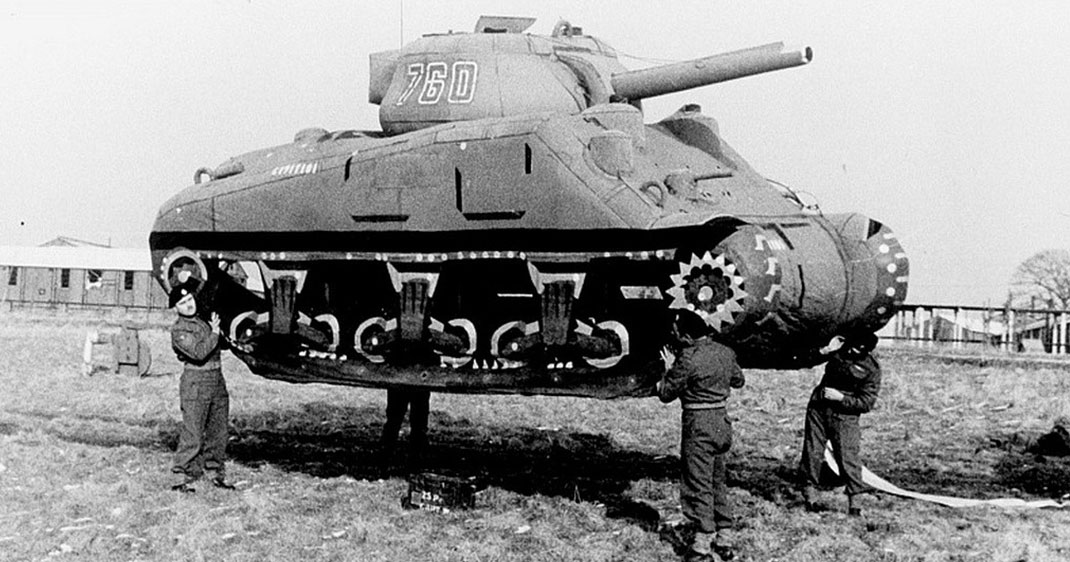Operation Fortitude
Preparations for the Normandy landing
Intelligence warfare
An inflatable tank representing a Sherman M4 tank and supposed to deceive the German aerial reconnaissance missions as part of Operation Fortitude. Photo: IWM
Beginning in 1943, Operation Round-up begins. The Anglo-Americans transfer a large part of their military personnel to England and these maneuvers are noticed by the Axis forces, who are closely interested in these movements. The Germans quickly realized that this was a large-scale amphibious offensive in preparation.
To learn more, and to adapt their alerts, the Axis intelligence services reinforce their presence in England. The Allies, who were expecting a resurgence of German and Italian agents, decided to set up a center to send false information in order to disorient foreign services. This was the birth of Operation Fortitude, headed by the Control Section in London.
The false information sent by the Control Section is varied: for example, « punching » operations by British commandos are reported by London, as are movements of troops to Norway or to the Pas-de-Calais. The main objective of this strategy is to remove the Germans from Normandy and to deceive them about the preparations for the landing.
A rubber army
In order to increase the disinformation effect of the German forces, the Allies decide to build inflatable lures which, seen from a reconnaissance plane, lead to believe real units. The campaign in the south-east of England thus saw a large quantity of artificial carriages, transport and artillery, painted with the marks of the 3rd Army commanded by the boiling and dreaded General Patton. In the ports of the Dover region, warships and wooden or rubber transport vessels were set up.
This action of disappointment consists of two distinct operations, one American (Operation Quicksilver, entrusted to Patton), the other British (Operation Skye). Operation Skye involves mobilizing a fake army (4th Army) in southern Scotland and in Ireland to simulate landing preparations in Norway.
The Germans were initially given information from their reconnaissance aircraft, which indicated that a gigantic army was being organized in England, just opposite the Pas-de-Calais. Indeed, the Luftwaffe aircraft are quite surprised to be able to fly relatively easily over the south-eastern region of England, although this was not possible before the beginning of 1944, because of the large number of patrols British in this area.
In reality, the British Airmen of the Royal Air Force were ordered to move away from the German reconnaissance aircraft, but they still had to defeat the enemy bombers. German pilots can thus photograph the allied sites which they consider to be genuine engines, but which in fact are only inflatable balloons adopting the form of tanks, cannons or warships.
A deception amphibious assault
The allied strategy aims to protect both the preparations for Operation Overlord, but also the very progress of this offensive. Indeed, the Anglo-American military leaders are aware that the first 48 hours of Overlord are decisive. They have to land very quickly as many units as possible in order to resist the probable German counter-attacks.
In order to have time to establish a relatively solid bridgehead in Normandy, the London Control Section, a few hours before D-Day, started a series of maneuvers indicating that a large-scale amphibious allied attack was in progress. Course in front of the Pas-de-Calais. The Germans will have to maintain an important military force in this region, if they fall into the trap, a force that would not be used in another area of operation, as in Normandy.
Aerial bombardment is much more intense in northern France, and particularly in front of Dover, since May 1944. During the night of 5-6 June 1944, several thousand tons of bombs were dropped by Allied bombers in the region of Pas-de-Calais. German soldiers of the 15th Army are placed on alert: their generals fear an allied landing in this area.
To add to the confusion, a squadron of small boats emitting false radio communications left the ports of the southeast on 5 June 1944 in the evening and then headed for the north of France. The German surveillance operators observe large echoes on their radar and give the alarm: for Germany, the landing will take place, it will be done in Pas-de-Calais.
The trap of the Fortitude operation stretched by the London-based control section works wonders. On D-Day, disturbed by numerous contradictory reports from the Pas-de-Calais and Normandy on the night of June 5-6, 1944, the Germans considered landing on the beaches of Basse-Normandie as a diversion, while the actual landing will take place in the Pas-de-Calais.
The German generals are convinced that the landing in Normandy is merely a diversion in spite of the means employed. They chose to keep alert the 150,000 men of the 15th Army in the Pas-de-Calais and decided not to send these troops to fight in Normandy. Operation Fortitude is a great success, to such an extent that the Germans will not engage the 15th Army until August 1944.

